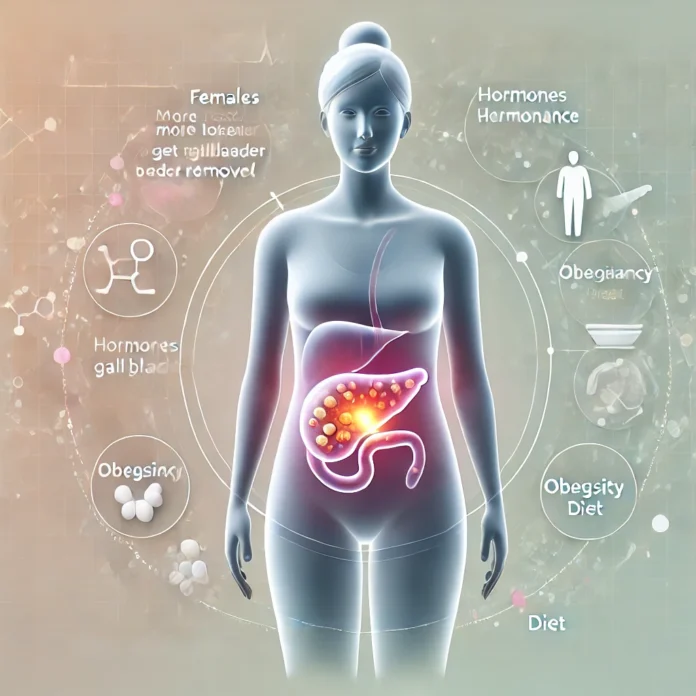Although people of both sexes have to deal with gallbladder removal for various medical reasons, women undergo this procedure more frequently. One of the reasons for this might be the varying disease symptoms and deterioration patterns seen across different gender groups. This article attempts to address the question, why do females get their gallbladder removed more frequently than men?
Why Do Women Remove Their Gall Bladder More Often than Men?
A gallbladder is a fist-sized organ located just beneath the liver. It stores bile produced from the liver and releases it when it is required during the intestinal digestion process. Apart from some rare congenital anomalies, everybody is born with a gall bladder. But for some people, especially those over 45 years, gall bladder removal surgery is required; possibly due to stones that can cause blockages, inflammation, infection, or other gallbladder diseases.
Physiological and Hormonal Reasons:
- Certain types of combined contraceptive pills significantly increase the risk of gallbladder diseases that result from cholecystitis or cholelithiasis.
- Pregnancy increases the risk as it lowers the tone of the gall bladder and increases estrogen secretion which tends to relax it. Birth control pills, hormone replacement therapy, and pregnancy are all linked with an increased risk of abnormal bile secretion during gall bladder inflammation, which removes the bile.
- Women, on average, tend to have a higher occurrence rate of gallstones than men. Out of the total cases of gallbladder removal performed, 70 to 85% is necessary because of gallstones, and out of all the women compared, 30% are more likely to have gallstones than men.
- Women between the ages of 20-60 are the most vulnerable group due to hormone changes.
Changes Occurring During Pregnancy
- Higher levels of estrogen and progesterone, which accompany pregnancy, result in the suspension of the gallbladder’s emptying phase, therefore predisposing towards gallstone development.
- A considerable number of women tend to suffer from gallbladder disease during or shortly following pregnancy.
Effects of Specific Dietary and Lifestyle Choices
- High fat and cholesterol diets are associated with gallbladder disease.
- Women are more prone to go on a very low-calorie diet or rapid weight-reducing plan, which is detrimental to the gallbladder.
Common Signs Suggesting Gallbladder Problems
Gallbladder disease reveals different signs, which include the following:
- Acute abdominal pain, particularly in the upper right region or mid-central part of the abdomen.
- Vomiting and nausea
- Excessive flatulence and stomach bloating
- Belly pain after intake of fatty meals
- Fever with chills especially with the presence of infection
Diseases that Make it Necessary to Remove the Gallbladder
The following diseases justify the need to perform cholecystectomy:
- Cholelithiasis: Gallstones are formed by hardened bile. It can obstruct bile ducts resulting in inflammation and pain.
- Cholecystitis: Severe pain due to inflammation of the gallbladder as a result of infections or gallstones besides requiring immediate medical attention.
- Gallbladder Polyps: There is no question about the necessity of removal of large polyps that have a suspicious nature even though most of these are not colon cancer-causing.
- Biliary Dyskinesia: This is a clinical condition in which there is an abnormal movement of the gallbladder, causing discomfort in digestion owing to pain.
Diagnosis and Treatment Options
Physicians diagnose problems with the gallbladder through:
- Imaging via ultrasound.
- CT scan or MRI.
- HIDA scan (to check the gallbladder’s functioning).
- Blood test for infection or liver malfunction.
Treatment Approaches
Changing Lifestyles and Diets
A significant change in one’s life time can be brought by managing symptoms can be achieved by adhering to a balance of reduced fat intake while increasing dietary fiber. Preventing animal protein-based large meals while maintaining acceptable body weight can also ameliorate gallbladder problems.
Drug Therapy
There are a few special drugs approved for treating gallstones that are less than 3cm, though they are not usually prescribed for prolonged use.
Surgery in the form of Cholecystectomy:
Surgical excision of the gall bladder is the most widely performed operating procedure for gallbladder disease. This is normally done by laparoscopic cholecystectomy which is a keyhole surgery with minimal clefts and prompt rehabilitation.
After Surgery Life without the Gallbladder
Most people do lead a normal life post the removal of the gallbladder and live with little pills and restrictions to their diet like:
- Consume several small meals rather than a few large ones.
- Eliminate fat and oil-based food.
- Drinking sufficient fluids and eating more vegetables and fruits while abstaining from grains.
FAQs
Is it possible to live a commendable life without a gallbladder?
The level of discomfort that one feels in dietary habits may change, but the liver continues to produce bile and therefore allows one to live a comforted life with or without a gallbladder.
How much time does one take to recuperate from gallbladder removal?
Generally, most people recuperate from laparoscopic procedures within 1-2 weeks while for open procedures they will take 4-6 weeks to recuperate.
Can one’s gallstones be treated without surgery?
Some medications or other forms of treatments, aside from surgery, do exist but are not guaranteed to work, thus surgery remains the most dependable form of treatment.
Can a person’s ability to digest be compromised without the gallbladder?
Some patients can develop a transient form of diarrhea or have problems with fat metabolism, but these usually resolve with time.
What are the chances of complications in patients who have undergone gallbladder removal?
Most patients do not have problems but some of them may experience a few alterations in their digestive system which are not serious but may need some dietary modification.
Conclusion:
Gallbladder removal is very common and is more so in women because of hormonal and pregnancy changes, and diet. While gallbladder disease is very painful it is easily resolved through surgery. After surgery, the patient remains free of pain with some lifestyle changes.


